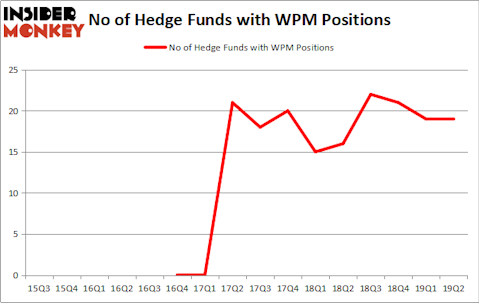Investing in small cap stocks has historically been a way to outperform the market, as small cap companies typically grow faster on average than the blue chips. That outperformance comes with a price, however, as there are occasional periods of higher volatility. The last 12 months is one of those periods, as the Russell 2000 ETF (IWM) has underperformed the larger S&P 500 ETF (SPY) by more than 10 percentage points. Given that the funds we track tend to have a disproportionate amount of their portfolios in smaller cap stocks, they have seen some volatility in their portfolios too. Actually their moves are potentially one of the factors that contributed to this volatility. In this article, we use our extensive database of hedge fund holdings to find out what the smart money thinks of Wheaton Precious Metals Corp. (NYSE:WPM).
Wheaton Precious Metals Corp. (NYSE:WPM) shares haven’t seen a lot of action during the second quarter. Overall, hedge fund sentiment was unchanged. The stock was in 19 hedge funds’ portfolios at the end of the second quarter of 2019. At the end of this article we will also compare WPM to other stocks including Roku, Inc. (NASDAQ:ROKU), Jack Henry & Associates, Inc. (NASDAQ:JKHY), and PTC Inc (NASDAQ:PTC) to get a better sense of its popularity. Our calculations also showed that WPM isn’t among the 30 most popular stocks among hedge funds (see the video below).

Video: Click the image to watch our video about the top 5 most popular hedge fund stocks.
Hedge funds’ reputation as shrewd investors has been tarnished in the last decade as their hedged returns couldn’t keep up with the unhedged returns of the market indices. Our research has shown that hedge funds’ small-cap stock picks managed to beat the market by double digits annually between 1999 and 2016, but the margin of outperformance has been declining in recent years. Nevertheless, we were still able to identify in advance a select group of hedge fund holdings that outperformed the market by 40 percentage points since May 2014 through May 30, 2019 (see the details here). We were also able to identify in advance a select group of hedge fund holdings that underperformed the market by 10 percentage points annually between 2006 and 2017. Interestingly the margin of underperformance of these stocks has been increasing in recent years. Investors who are long the market and short these stocks would have returned more than 27% annually between 2015 and 2017. We have been tracking and sharing the list of these stocks since February 2017 in our quarterly newsletter.

Unlike some fund managers who are betting on Dow reaching 40000 in a year, our long-short investment strategy doesn’t rely on bull markets to deliver double digit returns. We only rely on hedge fund buy/sell signals. We’re going to take a glance at the latest hedge fund action encompassing Wheaton Precious Metals Corp. (NYSE:WPM).
How are hedge funds trading Wheaton Precious Metals Corp. (NYSE:WPM)?
At Q2’s end, a total of 19 of the hedge funds tracked by Insider Monkey held long positions in this stock, a change of 0% from one quarter earlier. On the other hand, there were a total of 16 hedge funds with a bullish position in WPM a year ago. So, let’s review which hedge funds were among the top holders of the stock and which hedge funds were making big moves.

More specifically, Kopernik Global Investors was the largest shareholder of Wheaton Precious Metals Corp. (NYSE:WPM), with a stake worth $73.7 million reported as of the end of March. Trailing Kopernik Global Investors was Horizon Asset Management, which amassed a stake valued at $72.2 million. Sprott Asset Management, Renaissance Technologies, and Driehaus Capital were also very fond of the stock, giving the stock large weights in their portfolios.
Because Wheaton Precious Metals Corp. (NYSE:WPM) has experienced a decline in interest from the aggregate hedge fund industry, logic holds that there lies a certain “tier” of money managers who sold off their positions entirely in the second quarter. It’s worth mentioning that Cliff Asness’s AQR Capital Management cut the biggest stake of the 750 funds watched by Insider Monkey, worth close to $26.3 million in stock, and William Harnisch’s Peconic Partners LLC was right behind this move, as the fund dropped about $24.4 million worth. These moves are important to note, as aggregate hedge fund interest stayed the same (this is a bearish signal in our experience).
Let’s also examine hedge fund activity in other stocks – not necessarily in the same industry as Wheaton Precious Metals Corp. (NYSE:WPM) but similarly valued. We will take a look at Roku, Inc. (NASDAQ:ROKU), Jack Henry & Associates, Inc. (NASDAQ:JKHY), PTC Inc (NASDAQ:PTC), and The Trade Desk, Inc. (NASDAQ:TTD). This group of stocks’ market values match WPM’s market value.
| Ticker | No of HFs with positions | Total Value of HF Positions (x1000) | Change in HF Position |
|---|---|---|---|
| ROKU | 33 | 550484 | 0 |
| JKHY | 18 | 132769 | 1 |
| PTC | 23 | 1197320 | -2 |
| TTD | 24 | 348201 | -1 |
| Average | 24.5 | 557194 | -0.5 |
View table here if you experience formatting issues.
As you can see these stocks had an average of 24.5 hedge funds with bullish positions and the average amount invested in these stocks was $557 million. That figure was $291 million in WPM’s case. Roku, Inc. (NASDAQ:ROKU) is the most popular stock in this table. On the other hand Jack Henry & Associates, Inc. (NASDAQ:JKHY) is the least popular one with only 18 bullish hedge fund positions. Wheaton Precious Metals Corp. (NYSE:WPM) is not the least popular stock in this group but hedge fund interest is still below average. Our calculations showed that top 20 most popular stocks among hedge funds returned 24.4% in 2019 through September 30th and outperformed the S&P 500 ETF (SPY) by 4 percentage points. A small number of hedge funds were also right about betting on WPM as the stock returned 8.9% during the same time frame and outperformed the market by an even larger margin.
Disclosure: None. This article was originally published at Insider Monkey.


